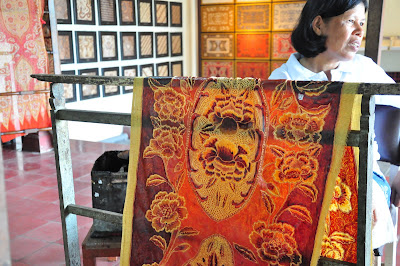While traipsing around Indonesia, daring each other to drink kopi luak (coffee made from fermented beans literally shat out by cats), I noticed a bunch of guys in dresses. Yep, EXTREMELY good times.
The sarong, also affectionately known as the Asian Kilt, is still very much in use in Indonesia. And I must say, it is great. Do you know how hot it is in that jungle? Goddamn, now I know why girls love wearing skirts. It's breezy! And yes, real men go commando under their sarongs.
Batik is this amazing thing that is made in South East Asia. It is a specific type of cloth that is created in a specific way (more on the process in a bit). In Indonesia, you can find the decorative cloth being used in a variety of ways, from collared shirts to handkerchiefs to place mats to man-dresses.
Here are a two examples of popular batik sarong styles as worn by men:

Fashion forward dude chillin' in a great shirt that brings out the highlights and patterns on his batik sarong. He's also accessorized with a cute little salmon sash. Kind of wish he'd gone with a complimentary color for the sash to better accent his waist, but hey, to each his own.

Look numero dos is another popular way men show off their beautiful batik. The look is achieved by layering a simple sarong with a very tamed trim above a more intricately designed batik pattern to subdue what could easily become tacky. The fancy front knot (a little difficult to see in this shot) also brings the sarong just high enough to smartly display his sturdy mankles. The dapper gentleman definitely understands that in fashion, sometimes less is more.
While in Indonesia, I was fortunate enough to visit a batik studio and got to see first hand how these precious pieces of jungle couture are made. It's a fascinatingly laborious process.
Now, LeVar Burton on Reading Rainbow style: Listen closely, friends, as I share with you the lessons I've learned!

Tools of the trade. On the upper right-hand corner are blocks of solid wax which are melted in the bowl-wax-melter-thing (red contraption to the left of the wax). Beneath the wax is an array of wooden handles with metal spouts which are filled with the melted wax before it's applied to the fabric. They also use stamps (square carved with the rooster), to apply intricate patterns to the fabric much faster.

Before the fabric can become batik, the designer decides which patterns will go on her carte blanche. Some patterns are predetermined by templates, but some batik artists, like this fine woman, just goes at it freehand. She draws from centuries-old patterns with each having its own meaning. For example, certain patterns can show where you're from, your social status, your thoughts of the weather, etc.

To get the show started, the batik artist takes one of the wooden handles and fills the cup on the tip with melted wax. The wax then drips down as she draws on complicated patterns handed down from generations upon generations of cultural history. The woman on the left was way ahead of the other woman and was all like, jeez girlfriend, hurry yo' ass up so we's can get paid coz I needs mah skrill to buy milk coz my baby daddy been left for Brunei like months ago and the lazy bastard sill ain't sent us no child support! And the other woman was all like, psshh chica, don't be rushin' me, you gotta chill coz we in paradise tho mija.

After the wax dries, the batik artist dips the entire piece of cloth in a single color of dye. The wax prevents the dye from coloring the cloth so you get a cool looking negative. Once the dye dries, the batik artist goes over the cloth again with wax and dips it again in dye to get another layer of color. This woman is only two colors in, but look at how awesome it looks already. I love how the jungle sun hits the opaque wax and dyed cloth. It's kind of poetic, or something.

The waxing and dying process is repeated over and over again until the design has been fully colored in and the cloth is laid out to dry one last time before the entire cloth is dipped in a solution that melts the wax off, revealing the product of hours upon hours of tedious work.

After countless hours of drawing and dripping and waxing and dying and drying and re-melting and such, the final product is something like this. A symphony of colors and patterns. Then, they charge you up to thousands of dollars (US) for pieces of cloth you can't wear outside of Indonesia and Malaysia without looking like a complete hippie. Yay, culture!
Hahaha, oh god. This is amazing.
ReplyDeleteComo estas guey?
Estoy bien, mas o menos. Menos que mas. Y tu, que tal?
ReplyDeletePS - Anonymous? Really? How mysterious of you.
Nada, lo mismo. Jajaja.
ReplyDeleteAhh, this reminds me. Have you heard of Pablo Neruda? He's a Spanish poet. Amazing stuff really. You should check him out.
And, I don't wanna sign into anything so Anon it is!
Of course I've read Neruda. I wouldn't be much of a hipster if I haven't. I used to ride around in my fixie with a collection of his poems in the back pocket of my skinny jeans.
ReplyDeleteAnd, you have fun with your digital obscurity.